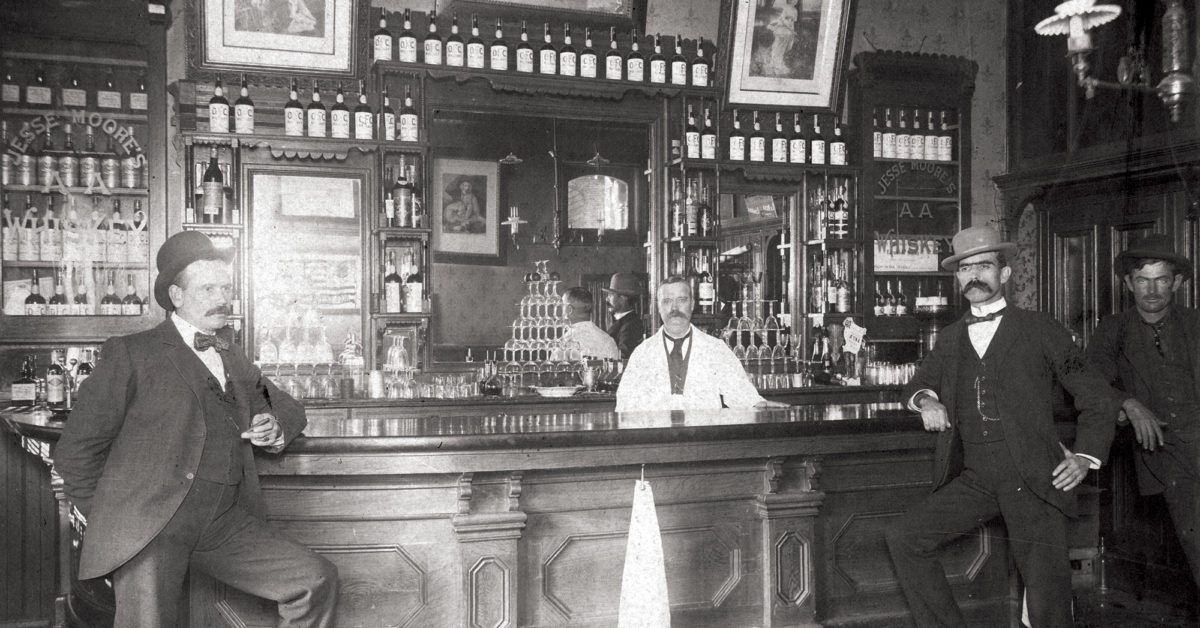A Wild West town without a saloon would be like a high-noon sky without a blazing sun. One with only one saloon would be like a night sky with but a single star—and not even a shooting one. In even the smallest, remotest of frontier settlements drinking establishments were integral to the landscape. When men, mostly young ones, consumed too much firewater, arguments, fisticuffs, gunplay and killings often ensued, either in the saloons themselves or on the dusty street just outside those swinging batwing doors. No doubt saloon shenanigans didn’t happen every week in the real West, as they did on most of those 1950s–60s TV Westerns. But towns from Deadwood to Tombstone, no matter how many ordinances officials passed or how much law they hired, couldn’t stop the vice or the violence.
Consider the following well-documented shootings triggered at least in part by whiskey consumption. On July 17, 1870, at Paddy Welch’s saloon in Hays City, Kan., Ellis County Sheriff Wild Bill Hickok mortally wounded one 7th U.S. Cavalry trooper and wounded another who recovered. On Nov. 1, 1875, at Henri Lambert’s saloon (present-day St. James Hotel) in Cimarron, New Mexico Territory, Clay Allison fired three shots into Francisco “Pancho” Griego. On Aug. 2, 1876, at Nuttall & Mann’s Saloon No. 10 in Deadwood, Dakota Territory, Jack McCall murdered Hickok. On April 5, 1879, in Dodge City’s Long Branch saloon, “Cockeyed Frank” Loving bested Levi Richardson in a gunfight. On Feb. 25, 1881, outside the Oriental Saloon in Tombstone, Arizona Territory, Luke Short killed Charlie Storms with a bullet to the heart. On Feb. 8, 1887, outside Fort Worth’s White Elephant saloon, Short was at it again, gunning down Jim Courtright. That list, of course, only touches on the saloon mayhem in the Old West. “A man with ready access to both liquor and guns could be a dangerous hombre,” writes Fort Worth author Richard F. Selcer. “If he had psychological problems to boot, he was a ticking time bomb.”
Pouring shots of whiskey was only part of a good frontier bartender’s job. The work could be dangerous, and he needed to be plenty tough
Even the ubiquitous if overlooked men who poured drinks sometimes got in the middle of the saloon madness, notes Selcer, whose article “Please Don’t Shoot the Bartender” appears in the April 2022 issue. As an example, he points to Fort Worth saloon man William T. Grigsby, who on June 22, 1887, without saying a word, fatally shot a friend in his Unique saloon. Other friends of the usually quiet, gentlemanly bartender “passed off the episode as a case of temporary insanity brought on by bad whiskey.” Grigsby not only avoided jail but also, in 1907, was granted another saloon license. “One can’t keep a good bartender down,” writes Selcer.
Pouring shots of whiskey was only part of a good frontier bartender’s job. The work could be dangerous, and he needed to be plenty tough, especially if he tended bar in one of the hole-in-the-wall saloons frequented by a rough clientele and lacking a bouncer. But he also needed to have a sympathetic ear, even in fancy saloons, for those customers looking for a confidant or mediator. The bartender, whether he owned the establishment or not, was always the man to see. A bad one was usually bad for business, a good one hard to replace. “The name ‘saloon’ was a badge of pride in the Old West,” Selcer says, “a beacon of light and a social center for thirsty gents of all stripes.”
Certainly most 19th-century Westerners didn’t arrive at a saloon looking to fight or to shoot somebody. Patrons were typically shopkeepers, farmers, ranchers, railroad workers and miners who wanted to drink, gamble, talk, relax and perhaps stave off loneliness. Few of these frontier towns had community centers, and church services were usually held only on Sunday, so saloons served as social outlets. Not that a bartender was a social director, but he usually was a good source of information about what games of chance were open, who the players were and what was going on about town. When I think of bartenders, I see the faces of those character actors who have played them in so many Westerns. Foremost, I picture 6-foot-5, craggy-faced Glenn Strange who played bartender Sam Noonan on Gunsmoke, a soft-spoken man who had no problem working tirelessly for a woman (Miss Kitty, portrayed by Amanda Blake) but on occasion would raise a shotgun for the good of the Long Branch or Dodge City. He was nobody to mess with. In three 1940s Universal horror films Strange played Frankenstein’s monster. WW
Wild West editor Gregory Lalire’s historical novel The Call of McCall is due out in July 2022. His earlier novels include 2021’s Man From Montana, 2019’s Our Frontier Pastime: 1804–1815 and 2014’s Captured: From the Frontier Diary of Infant Danny Duly. His short story “Halfway to Hell” appears in the 2018 anthology The Trading Post and Other Frontier Stories.





